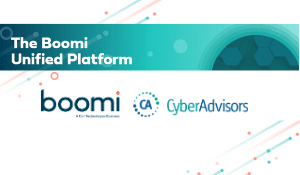In the last few months, my view of technology has changed significantly. The past has been filled with data center strategy discussions and complex cloud conversations. We all know this is where the world is taking us from the IT Transformation strategy…but, what is your DIGITAL Transformation strategy?
In my new role as VP of Strategy, I am afforded the luxury of making more time to get in front of our customers as well as to help Cyber Advisors innovate. The last few weeks have been filled with many great customer dialogues about how to keep them competitive in their market. Digital Transformation is all about being competitive and is the topic of this article.
To understand Digital Transformation, let’s first define a few things:
Digital Blindspot: An unexpected “change” or “offering” of technology or offering by your competitor that gives them an advantage with their solution over yours.
IT Automation: Transforming the IT portion of your business to allow for automated tasks rather than manual tasks.
Modernized App/Dev: Ability to provide enhancement to applications or new applications to your customers extremely fast.
Digital Mutation: A “middle-man” inserted by a competitor into your business model that forces you to completely change how you offer your solution or services – or in some cases, it completely changes how you do business.
Let’s take below example for instance:
Years ago, if you wanted to book a hotel room, you had two choices… 1) Call the hotel; 2) Get on their website to book. This wasn’t the easiest way to book a room, as you didn’t have very effective means to compare pricing, check availability, or get feedback from existing guests on the quality of the hotel. But, in hindsight, what choice did you have?
Then, a few years ago, a company called Bookings.com was created. As I am sure most of you have used them - the above items that may be tedious tasks are now at your fingertips. Hotel info is readily available simply by browsing from your smartphone or installing the Bookings.com app. Rarely do we go to the hotel website for booking a room.
Now let’s take a look at Bookings.com from the hotel’s standpoint. Few people know that bookings.com takes up a significant piece of the margin from the hotel simply to provide the service of booking the rooms. Large hotel chains had a DIGITAL BLINDSPOT in their rearview mirror, and didn’t know it. Hotel revenues dropped and CEOs were worried. Website traffic to the hotel website dropped considerably, making it difficult on marketing teams. Bookings.com performed DIGITAL MUTATION against the hotels, and the hotels couldn’t do anything about it.
A company like Bookings.com has a MODERNIZED APP/DEV platform that allows them to make changes to their web portal nearly instantly, which allows for a great customer experience. Additionally, they use significant IT AUTOMATION, to keep manual tasks to a minimum, reducing the time to market overhead.
Do you think the taxi companies realized the Digital Blindspot and Digital Mutation that they had in store when Uber and Lyft came about? When is the last time you took a taxi? I surely enjoy the ability to know where my driver is and what the cost will be even before I secure an Uber. Oh, and if the Uber app isn’t working, I switch to Lyft. But, knowing the swiftness of Uber, they will be back working in a few minutes again.
Anyone with a decent car can start an Uber service nearly the same day you apply. To start a taxi in a significant city, you’d better have a couple hundred grand in your pocket, as that is the cost to purchase a taxi on your own. Digital Mutation at its finest folks…
Here are a few questions that business leadership should be asking themselves as it pertains to Digital Transformation.
- Who is potentially in our digital blindspot?
- Should we create an innovation role in our organization?
- What would happen if we lost our best customer tomorrow?
- Should we be offering an app to our customers?
- Does the software we purchase “off the shelf” give us the flexibility to serve our customers?
- What can we do to accelerate IT in our business to give our employees and customers a better experience?
- How fast can we respond to a customer need/concern and does that align with our technology capabilities today?
- If we need to digitally transform, is that a marketing expense?
The above questions are a small sample that I use to get a conversation going with business leadership. We are entering a technology phase where it seems all companies are now software companies. Cyber Advisors has created some great offerings around this. Please engage with your account executive to allow us to facilitate this meeting with business leadership.



